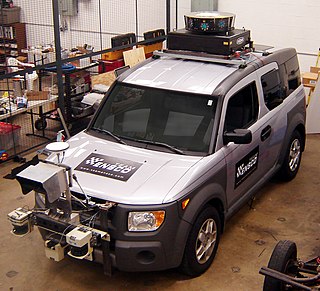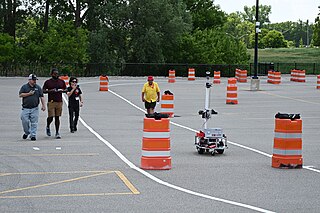The DARPA Grand Challenge is a prize competition for American autonomous vehicles, funded by the Defense Advanced Research Projects Agency, the most prominent research organization of the United States Department of Defense. Congress has authorized DARPA to award cash prizes to further DARPA's mission to sponsor revolutionary, high-payoff research that bridges the gap between fundamental discoveries and military use. The initial DARPA Grand Challenge in 2004 was created to spur the development of technologies needed to create the first fully autonomous ground vehicles capable of completing a substantial off-road course within a limited time. The third event, the DARPA Urban Challenge in 2007, extended the initial Challenge to autonomous operation in a mock urban environment. The 2012 DARPA Robotics Challenge, focused on autonomous emergency-maintenance robots, and new Challenges are still being conceived. The DARPA Subterranean Challenge was tasked with building robotic teams to autonomously map, navigate, and search subterranean environments. Such teams could be useful in exploring hazardous areas and in search and rescue.
The Centennial Challenges are NASA space competition inducement prize contests for non-government-funded technological achievements by American teams.

An unmanned ground vehicle (UGV) is a vehicle that operates while in contact with the ground and without an onboard human presence. UGVs can be used for many applications where it may be inconvenient, dangerous, or impossible to have a human operator present. Generally, the vehicle will have a set of sensors to observe the environment, and will either autonomously make decisions about its behavior or pass the information to a human operator at a different location who will control the vehicle through teleoperation.

Stanley is an autonomous car created by Stanford University's Stanford Racing Team in cooperation with the Volkswagen Electronics Research Laboratory (ERL). It won the 2005 DARPA Grand Challenge, earning the Stanford Racing Team a $2 million prize.

William L. "Red" Whittaker is an American roboticist and research professor of robotics at Carnegie Mellon University. He led Tartan Racing to its first-place victory in the DARPA Grand Challenge (2007) Urban Challenge and brought Carnegie Mellon University the two million dollar prize. Previously, Whittaker also competed in the DARPA Grand Challenge, placing second and third place simultaneously in the Grand Challenge Races.

The International Aerial Robotics Competition (IARC) is a university-based robotics competition held on the campus of the Georgia Institute of Technology. Since 1991, collegiate teams with the backing of industry and government have fielded autonomous flying robots in an attempt to perform missions requiring robotic behaviors not previously exhibited by a flying machine. The term “aerial robotics” was coined by competition creator Robert Michelson in 1990 to describe a new class of small highly intelligent flying machines. Successive years of competition saw these aerial robots grow from vehicles that could barely maintain themselves in the air, to automatons which are self-stable, self-navigating, and able to interact with their environment.

A robot competition is an event where the abilities and characteristics of robots may be tested and assessed. Usually they have to outperform other robots in order to win the competition. Many competitions are for schools but several competitions with professional and hobbyist participants also exist.
The United States Army DEVCOM Ground Vehicle Systems Center (GVSC) (formerly United States Army Tank Automotive Research, Development and Engineering Center (TARDEC)), located in Warren, Michigan, is the United States Armed Forces' research and development facility for advanced technology in ground systems. It is part of the U.S. Army Combat Capabilities Development Command (DEVCOM), a major subordinate command of the U.S. Army Futures Command. GVSC shares its facilities with the United States Army Tank-automotive and Armaments Command (TACOM). Current technology focus areas include Ground Vehicle Power and Mobility (GVPM), Ground System Survivability and Force Protection, among others.

The third driverless car competition of the DARPA Grand Challenge was commonly known as the DARPA Urban Challenge. It took place on November 3, 2007 at the site of the now-closed George Air Force Base, in Victorville, California, in the West of the United States. Discovery's Science channel followed a few of the teams and covered the Urban Challenge in its RobocarsArchived 2008-07-30 at the Wayback Machine series.
There are a number of competitions and prizes to promote research in artificial intelligence.
The Faculty of Engineering is a constituent body of the University of New South Wales (UNSW), Australia. UNSW was formed on 1 July 1949, and the Faculty was established on 8 May 1950 with the inaugural meeting of the Faculty taking place on 7 June 1950. It was one of the first three University faculties which were established by Council, and was initially formed of four departments including Electrical Engineering, Mechanical Engineering, Civil Engineering and Mining Engineering, headed by Dean Professor Harold Brown.
The Guidance, Control and Decision Systems Laboratory (GCDSL) is situated in the Department of Aerospace Engineering at the Indian Institute of Science in Bangalore, India. The Mobile Robotics Laboratory (MRL) is its experimental division. They are headed by Dr. Debasish Ghose, Full Professor.

The UAV Challenge - Outback Rescue, also known as the UAV Outback Challenge or UAV Challenge, is an annual competition for the development of unmanned aerial vehicles. The competition was first held in 2007 and features an open challenge for adults, and a high-school challenge. The event is aimed at promoting the civilian use of unmanned aerial vehicles and the development of low-cost systems that could be used for search and rescue missions. The event is one of the largest robotics challenges in the world and one of the highest stakes UAV challenges, with the current Medical Express version of the event offering $75,000 to the winner.

The 4D/RCS Reference Model Architecture is a reference model for military unmanned vehicles on how their software components should be identified and organized.

The Intelligent Ground Vehicle Competition (IGVC) is an annual international robotics competition for teams of undergraduate and graduate students. Teams may compete in either the AutoNav or Self Drive challenges. The competition is well suited to senior design capstone courses as well as extracurricular design projects.
The Learning Applied to Ground Vehicles (LAGR) program, which ran from 2004 until 2008, had the goal of accelerating progress in autonomous, perception-based, off-road navigation in robotic unmanned ground vehicles (UGVs). LAGR was funded by DARPA, a research agency of the United States Department of Defense.

Experiments have been conducted on self-driving cars since 1939; promising trials took place in the 1950s and work has proceeded since then. The first self-sufficient and truly autonomous cars appeared in the 1980s, with Carnegie Mellon University's Navlab and ALV projects in 1984 and Mercedes-Benz and Bundeswehr University Munich's Eureka Prometheus Project in 1987. Since then, numerous major companies and research organizations have developed working autonomous vehicles including Mercedes-Benz, General Motors, Continental Automotive Systems, Autoliv Inc., Bosch, Nissan, Toyota, Audi, Volvo, Vislab from University of Parma, Oxford University and Google. In July 2013, Vislab demonstrated BRAiVE, a vehicle that moved autonomously on a mixed traffic route open to public traffic.
Torc Robotics (Torc), an independent subsidiary of Daimler Truck, is an American autonomous truck company headquartered in Blacksburg, Virginia, with operations in Albuquerque, New Mexico; Austin, Texas; and Stuttgart, Germany. Torc is testing autonomous trucks in Virginia, New Mexico, and Texas and is taking a pure play approach to commercialization – focusing at first on one platform in one region.

Chan-Jin Chung, commonly known as CJ Chung, is a full professor of computer science at Lawrence Technological University (LTU) in Michigan, USA. He founded an international autonomous robotics competition called Robofest in the 1999–2000 academic year as well as numerous educational programs for youth by integrating STEM, arts, autonomous robotics, and computer science. He also served as the founding USA National Organizer of World Robot Olympiad (WRO) in 2014 and 2015. He also started the WISER conference in 2014. He is working on developing a computer science curriculum for connected and autonomous vehicles (CAV) with a support from National Science Foundation . His research areas include evolutionary computation, cultural algorithms, intelligent systems & autonomous mobile robotics, software engineering,

The Indy Autonomous Challenge (IAC) is the main and, as of July 2023, the only active racing series for autonomous race cars. The vehicles participating in the IAC are SAE level 4 autonomous as they are capable of completing circuit laps and overtaking manoeuvres without any human intervention.












